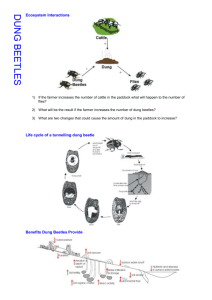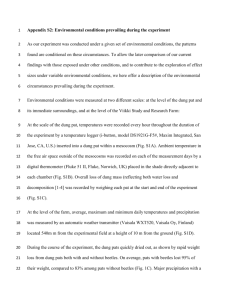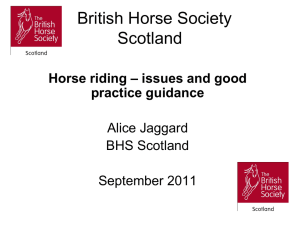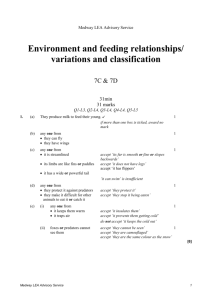Final Report Interagency Special Status/Sensitive Species Program Inventory and Conservation Planning
advertisement
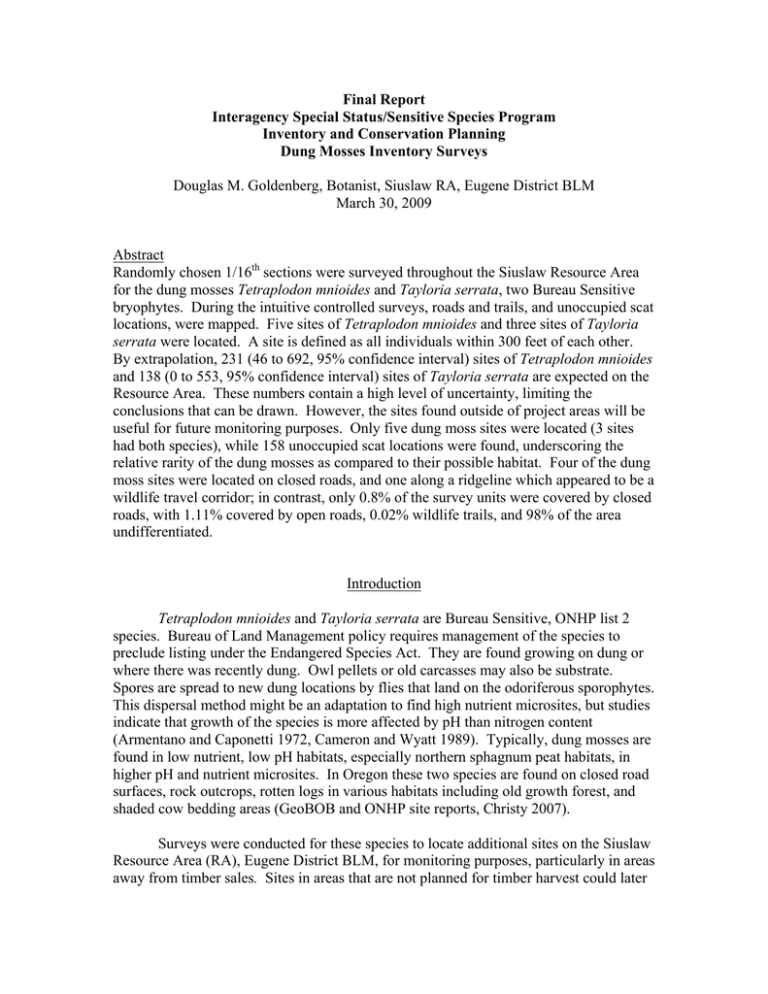
Final Report Interagency Special Status/Sensitive Species Program Inventory and Conservation Planning Dung Mosses Inventory Surveys Douglas M. Goldenberg, Botanist, Siuslaw RA, Eugene District BLM March 30, 2009 Abstract Randomly chosen 1/16th sections were surveyed throughout the Siuslaw Resource Area for the dung mosses Tetraplodon mnioides and Tayloria serrata, two Bureau Sensitive bryophytes. During the intuitive controlled surveys, roads and trails, and unoccupied scat locations, were mapped. Five sites of Tetraplodon mnioides and three sites of Tayloria serrata were located. A site is defined as all individuals within 300 feet of each other. By extrapolation, 231 (46 to 692, 95% confidence interval) sites of Tetraplodon mnioides and 138 (0 to 553, 95% confidence interval) sites of Tayloria serrata are expected on the Resource Area. These numbers contain a high level of uncertainty, limiting the conclusions that can be drawn. However, the sites found outside of project areas will be useful for future monitoring purposes. Only five dung moss sites were located (3 sites had both species), while 158 unoccupied scat locations were found, underscoring the relative rarity of the dung mosses as compared to their possible habitat. Four of the dung moss sites were located on closed roads, and one along a ridgeline which appeared to be a wildlife travel corridor; in contrast, only 0.8% of the survey units were covered by closed roads, with 1.11% covered by open roads, 0.02% wildlife trails, and 98% of the area undifferentiated. Introduction Tetraplodon mnioides and Tayloria serrata are Bureau Sensitive, ONHP list 2 species. Bureau of Land Management policy requires management of the species to preclude listing under the Endangered Species Act. They are found growing on dung or where there was recently dung. Owl pellets or old carcasses may also be substrate. Spores are spread to new dung locations by flies that land on the odoriferous sporophytes. This dispersal method might be an adaptation to find high nutrient microsites, but studies indicate that growth of the species is more affected by pH than nitrogen content (Armentano and Caponetti 1972, Cameron and Wyatt 1989). Typically, dung mosses are found in low nutrient, low pH habitats, especially northern sphagnum peat habitats, in higher pH and nutrient microsites. In Oregon these two species are found on closed road surfaces, rock outcrops, rotten logs in various habitats including old growth forest, and shaded cow bedding areas (GeoBOB and ONHP site reports, Christy 2007). Surveys were conducted for these species to locate additional sites on the Siuslaw Resource Area (RA), Eugene District BLM, for monitoring purposes, particularly in areas away from timber sales. Sites in areas that are not planned for timber harvest could later be monitored to determine site persistence in undisturbed areas, and better understand the ecology of these species. The project was designed as a probabilistic survey, consequently the information collected on these plots can be expanded to make statements on 160,456 acres of the Siuslaw Resource Area. Unoccupied scat locations, roads and trails were also recorded as these are the major habitat elements associated with these species on the Eugene District. The dung mosses Tetraplodon mnioides and Tayloria serrata have recently been discovered on the Eugene District, beginning in 2004. Not much is known about the ecology of these species, and there are unique factors with these species that complicate management. The longevity of sites and the turnover of sites are important questions. Dung moss individuals may be short-lived (< 5 years), yet individuals of various ages are found, so that the site is potentially long-lived1. Very often, individuals of various ages are found on dung in close proximity, along with freshly deposited dung, indicating habitual marking by the carnivores. Sites were found to be still extant after about 3 1/2 years since their original discovery, and fresh carnivore scat was deposited within feet of the mosses. These sites are potentially long-lived due to the habits of the carnivores, and sites may rarely form where repeated scat deposition does not occur. The carnivores involved have not been identified, but had in at least one case made a small scrape where the scat was deposited. Cougar, coyote, bobcat and fox are possibilities. Factors that would allow management for persistence of the larger populations are difficult to define. Because of the possibly dynamic nature of the metapopulation, management by protecting moss individuals may not be adequate. Because the substrate for these species (dung, particularly carnivore dung on the Eugene District) is probably common, it has been suggested that these species should be common, with a high turnover of many short-lived sites. However, the species appear to be rare, possibly because habitat and dispersal factors limit their abundance. On the Eugene District, the dung mosses appear to require fairly humid sites, on bare mineral soil or very rotten logs, where carnivore dung is habitually deposited. Canopy cover is generally intermediate, and often less than nearby dense forest. Elevations range from about 1400 feet to 2550 feet; lower elevation areas appear to lack the dung mosses. Most of the known sites have been impacted or will shortly be impacted by timber sales. Since they are found on old, overgrown road surfaces to be renovated, the sites are often not protected. Instead, the mosses are moved out of the way. Although this may allow for limited continued persistence of the individuals and the dispersal of their spores to new habitat, the moss may not persist long in the new location. In addition, wildlife habits could be disrupted by the timber sale, increasing the difficulty of moss spores dispersing to new dung in a suitable habitat. It appears likely that the life cycle of the moss would be disrupted such that the species may not persist long in the area after the timber sale. 1 A site is defined as all individuals within 300 feet of each other, following the standard from GeoBOB, the OR/WA BLM species location database. An individual is a clump of stems generally on a single scat; the stems may or may not be connected at their base or be the same genetic individual. Surveys over a wide area were proposed to obtain a better sense of the relative rarity and distribution of these species. This inventory survey was to give an estimate of the number of sites extant during a particular single year, which would be helpful in determining the rarity of the species. Before this survey, only 5 small sites of Tetraplodon mnioides and 4 sites of Tayloria serrata were known, all in a small area of the northwest Siuslaw Resource Area, Eugene District, on closed roads. More recently, sites have been found on the Upper Willamette Resource Area of the Eugene District. Methods A GIS layer was located which allowed random selection of 16th sections (Figure 1). The resulting blocks, averaging about 40 acres in size, were selected with probability proportional to the block size so that any particular acre would have an equal chance of being chosen. This method involves the construction of a table of blocks, their acreage, and cumulative acreage. Random numbers are drawn between one and the highest cumulative acreage, and then the corresponding block is selected. A portion of the sample table is as shown in Table 1. Table 1. Example showing the method of random sampling. The random number 353 resulted in the selection of block 9. Acres Sample Unit 34.93457 35.13824 39.57754 43.89097 37.10683 43.80338 44.98394 45.23275 40.87938 40.8995 41.52172 1 2 3 4 5 6 7 8 9 10 11 Cumulative acres 35 70 110 154 191 234 279 325 366 406 448 Selected Random numbers **353 1084 1888 2252 2295 5532 6131 Y** Coastal dunes, isolated blocks near the coast, and the West Eugene Wetlands area were deleted from the sample pool. These 1922 acres of deletions represent a fairly small, atypical portion of the Siuslaw RA. Also, very small slivers in the GIS layer caused by divisions into 16th sections, including any polygon less than 1 acre in size, were deleted. The deleted slivers sum to 156 acres. The sample pool totaled 160,456 acres, of the approximately 162,534 acres on the Siuslaw RA. Eighty-seven blocks, covering 3479 acres or 2.2% of the sample pool, were randomly selected and sampled. Figure 1. Location of Dung Moss Survey Units and Sites on the Siuslaw Resource Area. Surveyors, using a modified intuitive controlled technique, systematically gridded the survey block, and performed a more intensive survey following any road, overgrown road, or wildlife trail found. A contract inspection criteria requiring location of 90% of dung moss sites was used, i.e., if the inspector, looking for missed sites, found more than 1/10th the number of sites that the contractor found, and more than two missed sites, a rework would be required. Roads and trails were mapped, and their average width documented. The length was later calculated from field maps, and acreage then determined as length times width. Locations of any unoccupied carnivore scat were indicated on the map with a dot. Scat locations represent all scat within a small area, as mapped on 1:12,000 maps, not individual scat pieces. Standard site report forms were filled out for any dung mosses found, or other Special Status lichens and bryophytes found incidentally; this data was entered into GeoBOB, the OR/WA BLM species location database. Roads and trails were assigned to the following classes: Open: Open and drivable roads, although may be gated. ORV: Trails or roads that show signs of ORV (off-road vehicle) use and are created by ORV use, but are not drivable by standard vehicles and were not constructed as roads. Closed: Roads which are no longer drivable, as they are overgrown by trees and shrubs. These roads are generally the most likely habitat for dung mosses. Includes roads that have been recently closed by earthen berms, ditches, tilling and/or slash deposition, but are not yet well vegetated. Hiking: Trails that were constructed for hikers, horses, and mountain bikes. Wildlife: Significant trails created by wildlife use. Minor or vague skid trails were not mapped. These trails were defined as trails made by equipment used during logging and that no longer are used, did not involve stump removal, have revegetated, and are generally narrow (10-12 feet) and fairly undistinguished from surrounding forest floor. Short (100 feet or less) or vague (fairly undistinguished from surrounding forest floor) wildlife trails likewise were not mapped. Analysis of the number of dung moss sites, unoccupied scat locations, roads and trails was performed to extrapolate to the entire Siuslaw RA. Because the data contained many zeros (37% to 98% null values), parametric statistical procedures could not be used. Bootstrap percentile confidence intervals were calculated instead. For the dung moss site data, the BCa (bias-corrected and accelerated, Efron and Tibshirani 1993) bootstrap method was used instead, due to the very large number of zeros and skewed data. Spearman rank correlations were used to test for correlations among the variables. Data were analyzed using Statgraphics Online (http://www.statgraphicsonline.com/), or SAS for the BCa method. Results Sites of both dung moss species were located in the sample units, allowing extrapolation to the entire Siuslaw RA (Table 2). By extrapolation , 231 (46 to 692, 95% confidence interval) sites of Tetraplodon mnioides and 138 (0 to 553, 95% confidence interval) sites of Tayloria serrata are expected on the Resource Area. The extrapolation figures represent the probable results if the entire Resource Area were to be surveyed in the manner of the sample blocks. All of the Tayloria sites were located at Tetraplodon sites. Four of the dung moss sites were located on closed roads, and one, with both species, was located in an undifferentiated habitat area. The latter site was on a ridgeline with a vague wildlife travel corridor, on dung at the juncture of an old growth stand and a young plantation, with some individuals on rotten wood and deep duff, and some on an old skid trail scar. This ridgeline area did not meet our definition of a significant wildlife trail. Table 2. Dung moss and environmental variable results. Tetraplodon sites Tayloria sites Unoccupied scat locations Open roads (acres) Closed roads (acres) ORV trails (acres) Wildlife trails (acres) Count (sites, 5 3 158 38.8 28.2 0.3 0.6 locations) or sum (roads and trails) Extrapolation to 231 138 7287 1789 1299 12 26 the RA 95% CI lower 46 0 5442 1409 951 0 12 bound 95% CI upper 692 553 9501 2191 1690 31 45 bound Percent null 95% 98% 37% 39% 41% 98% 84% values* Relative 1.11% 0.81% 0.01% 0.02% coverage** * The percent of sample blocks with the number zero, i.e., no sites, locations or acres, of the 87 sample units. ** Percent of the total acreage sampled covered by road and trail classes. No hiking trails were located in the sample blocks. There are hiking trails on the RA, but only short sections in three areas. Spearman rank correlations were calculated (Table 3). Some of the variables were weakly correlated, as might be expected given the habitat relations of the species and wildlife travel habits. There are more scats and more dung moss sites in sample blocks with more acres of closed roads. Table 3. Spearman rank correlations among variables. Acres of Closed Roads Unoccupied Scat Locations 0.2154 (0.0457) Dung Moss Sites 0.3379 (0.0017) Dung Moss Sites 0.2655 (0.0138) Spearman Rank Correlation Coefficient (P Value) Discussion From the sample units, an estimate of the numbers of dung moss sites over the Siuslaw Resource Area was calculated. The estimates contain a high level of uncertainty, with wide confidence intervals, limiting the conclusions that can be drawn. In any case, it is difficult to determine whether a particular number in isolation denotes a species that is rare and threatened, or not. However, the dung mosses appear not very common, especially in comparison to the numbers of unoccupied scat and amount of available habitat. Sites are small and vulnerable, consisting of only 1 to 42 small individual clumps in an area of a few to several square meters. A site can be lost quickly when a road is renovated, as for a timber sale, or due to increased ORV use. Although the sampling occurred across almost the entire Resource Area, it cannot be assumed that the species are evenly distributed. The estimates quantify the number of sites that would be found somewhere within the survey area if the exact same survey methods were used on the entire survey area. The species are actually fairly localized on multiple levels. All Tayloria serrata sites found were intermixed at Tetraplodon mnioides sites in this study, although they have been found separate before. Five total dung moss sites were located (3 with both species), and these sites were localized to only four sample units, and only three square mile sections. All were in the extreme northwest portion of the RA (Figure 1). Although there are probably some sites in other parts of the RA, most appear to be in the northwest portion. These observations confirm the localized nature of the sites, which makes the species more vulnerable. Closed roads are obviously the most frequent habitat of the species, with closed roads, dung moss sites, and unoccupied scat locations all correlated. Wildlife takes advantage of these travel corridors, and the more or less bare mineral soil provides good substrate for growth. In more natural conditions, the dung mosses would be found where wildlife habitually frequent rock outcrops, sphagnum bogs, or rotten logs, or along wellworn wildlife trails. The relatively small number of ORV trails may seem surprising, but most ORV damage on the RA is confined to previously constructed road corridors. The estimated 12 acres of trail at 10 feet wide would be 10 miles of trail over the RA. In any case, ORV trails are not a significant habitat element for the dung mosses. This inventory illustrates the difficulty of sampling rare localized occurrences over a large area. Many sample units must be used to collect any useful data, and even then confidence intervals may be very wide. Rarity is also difficult to determine, in that a single number with a wide confidence interval has only vague biological meaning. More useful would be to repeat this inventory in future years to determine the direction the species is trending. Another useful modification to an inventory like this one would be to include other species that are thought to be common, to provide comparative metrics. The sites that were located will be very useful for monitoring purposes. In the past, all sites were found in timber sale units, and all sites were disturbed to some extent. Either the mosses were moved out of the way, or were buffered only minimally, with wildlife habit disruption not mitigated in any way. The sites found away from timber sales can represent good control sites, where site persistence can be monitored without disturbance. Site longevity will be an indicator of metapopulation dynamics, e.g., if sites are naturally long-lived, new site formation is less likely to be a common occurrence. Acknowledgments Thanks to Scot Loring, Josh Paque, and crew for performing the field work, and to Jim Alegria for statistical consultation. Reviewers include Daphne Stone, Dave Kofranek and Kelli VanNorman. References Armentano, T.V., and J.D. Caponetti. 1972. The effect of pH on the growth of protonemata of Tetraplodon mnioides and Funaria hygrometrica. The Bryologist 75: 147-153. Cameron, R.G., and R. Wyatt. 1989. Substrate restriction in entomophilous Splachnaceae: II. Effects of hydrogen ion concentration on establishment of gametophytes. The Bryologist 92(3): 397-404. Christy, J. 2007. Species Fact Sheet, Tayloria serrata. Interagency Special Status/Sensitive Species Program. USDA Forest Service and USDI Bureau of Land Management, Portland, OR. Available at: http://www.fs.fed.us/r6/sfpnw/issssp/planning-documents/speciesguides.shtml Christy, J. 2007. Species Fact Sheet, Tetraplodon mnioides. Interagency Special Status/Sensitive Species Program. USDA Forest Service and USDI Bureau of Land Management, Portland, OR. Available at: http://www.fs.fed.us/r6/sfpnw/issssp/planning-documents/speciesguides.shtml Efron, B. and R. Tibshirani. 1993. An introduction to the bootstrap. Chapman and Hall, New York.
